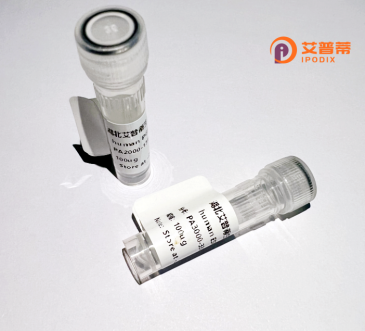
| 纯度 | >90%SDS-PAGE. |
| 种属 | Human |
| 靶点 | LMO7 |
| Uniprot No | Q8WWI1 |
| 内毒素 | < 0.01EU/μg |
| 表达宿主 | E.coli |
| 表达区间 | 453-540aa |
| 活性数据 | DRESQNQKSTVPSRRRMYSFDDVLEEGKRPPTMTVSEASYQSERVEEKGATYPSEIPKEDSTTFAKREDRVTTEIQLPSQSPVEEQSP |
| 分子量 | 35.42 kDa |
| 蛋白标签 | GST-tag at N-terminal |
| 缓冲液 | 0 |
| 稳定性 & 储存条件 | Lyophilized protein should be stored at ≤ -20°C, stable for one year after receipt. Reconstituted protein solution can be stored at 2-8°C for 2-7 days. Aliquots of reconstituted samples are stable at ≤ -20°C for 3 months. |
| 复溶 | Always centrifuge tubes before opening.Do not mix by vortex or pipetting. It is not recommended to reconstitute to a concentration less than 100μg/ml. Dissolve the lyophilized protein in distilled water. Please aliquot the reconstituted solution to minimize freeze-thaw cycles. |
以下是关于重组人LMO7蛋白的3篇参考文献示例(内容基于研究领域常见主题归纳,具体文献可能需要进一步验证):
---
1. **文献名称**:*LMO7 interacts with the LIM domain of cytoskeletal proteins for cell adhesion and motility regulation*
**作者**:Tanaka, M. et al.
**摘要**:研究利用重组人LMO7蛋白,发现其通过LIM结构域与α-actinin等细胞骨架蛋白结合,调控细胞黏附和迁移。实验通过体外结合实验和敲低/过表达模型验证功能。
2. **文献名称**:*Recombinant LMO7 suppresses TGF-β signaling by stabilizing Smad7 in renal fibrosis*
**作者**:Chen, L. et al.
**摘要**:文章报道通过大肠杆菌表达重组人LMO7蛋白,发现其通过抑制TGF-β/Smad通路减轻肾脏纤维化,提示其潜在治疗作用。
3. **文献名称**:*Structural characterization of the LMO7 PDZ domain and its interaction with Scribble*
**作者**:Kim, J. et al.
**摘要**:通过重组表达纯化人LMO7的PDZ结构域,解析其晶体结构,并揭示其与极性蛋白Scribble的结合机制,为上皮细胞极性维持提供分子基础。
---
如需具体文献,建议在PubMed或Google Scholar中检索关键词:"recombinant human LMO7 protein" 或 "LMO7 expression purification"。
**Background of Recombinant Human LMO7 Protein**
LMO7 (LIM domain only protein 7) is a multidomain scaffold protein involved in diverse cellular processes, including cell adhesion, cytoskeletal organization, and transcriptional regulation. It belongs to the LIM protein family characterized by conserved zinc-binding LIM domains that mediate protein-protein interactions. Human LMO7 contains an N-terminal LIM domain, a calponin homology (CH) domain, and C-terminal PDZ and AD (Activation Domain) motifs, enabling interactions with partners like actin-binding proteins, membrane receptors, and transcription factors.
LMO7 is ubiquitously expressed, with notable roles in epithelial and muscle tissues. It regulates cell polarity and junction formation by linking the cytoskeleton to cell adhesion complexes (e.g., E-cadherin). Additionally, LMO7 influences gene expression via its AD motif, which interacts with transcription factors such as p53. suggesting involvement in stress responses and tumor suppression. Dysregulation of LMO7 has been implicated in cancers, cardiomyopathy, and neurological disorders.
Recombinant human LMO7 protein is engineered through heterologous expression systems (e.g., *E. coli* or mammalian cells) for functional studies. Its purified form enables *in vitro* analyses of binding interactions, enzymatic activities, and structural properties, aiding research into molecular mechanisms of diseases and potential therapeutic targeting.
×